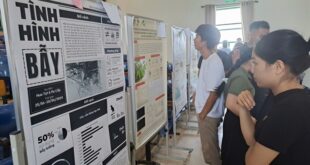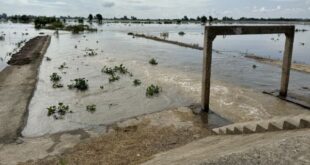 |
| Vân Long wetland nature reserve in Ninh Bình Province. By 2030, the total area of the protected nature reserves nationwide is expected to reach about 6.7 million hectares. — VNA/VNS Photo |
HÀ NỘI — Deputy Prime Minister Trần Hồng Hà has signed a decision approving the national environmental protection planning project for the 2021 – 2030 period, with a vision to 2050.
The planning project’s objectives are to proactively prevent and control environmental pollution and degradation; to restore and improve environmental quality; and to prevent decline and enhance biodiversity in order to ensure the people’s right to live in a healthy environment on the basis of rational spatial arrangement and management zoning of environmental quality.
It also aims to direct the establishment of nature reserves and biodiversity conservation areas; form centralised waste treatment zones at the national, regional, and provincial levels; orient the development of national and provincial environmental monitoring and warning networks; and promote sustainable socio-economic development towards green economy, circular economy and low-carbon economy, which is harmonious with nature, and environmentally friendly, and actively responds to climate change.
Specifically, the direction of environmental zoning will be uniformed on a national scale based on criteria of environmental sensitivity, which are prone to damage from pollution impacts. This aims to minimise negative impacts on the lives and normal development of human and creatures.
Meanwhile, natural values, biodiversity and natural heritage will be preserved to restore and maintain natural ecosystems, and prevent the trend of biodiversity loss on the basis of consolidating, expanding, establishing and effectively managing nature reserves, biodiversity corridors, high biodiversity areas, important natural landscapes, important wetlands and conservation facilities to store, conserve and develop endemic, endangered and rare genetic resources, and plant and animal varieties.
By 2030, the total area of the protected nature reserves nationwide is expected to reach about 6.7 million hectares.
Centralised waste treatment zones at the national, regional, and provincial levels will be formed with suitable capacity scales and treatment technologies, thus meeting the requirements of receiving and processing the entire amount of domestic solid waste, normal industrial solid waste and hazardous waste generated nationwide, minimising the amount of solid waste directly buried, classifying waste at source, and promoting recycling and reuse of waste.
Accordingly, by 2030, at least two national-level centralised waste treatment zones and at least seven regional-level ones in socio-economic regions during the planning period will be set up, and at least one provincial-level in each province or centrally-run city.
As for the national environmental monitoring and warning network, environmental monitoring and warning stations will be built at inter-regional, inter-provincial, and cross-border areas, and those of important significance for the country’s nature conservation and socio-economic development.
Under the planning project, by 2050, Việt Nam aims to achieve good environmental quality, ensure a healthy living environment for its people, effectively conserve biodiversity and maintain ecological balance. It will also actively respond to climate change, and advance towards sustainable development through a green transition based on the development of circular economy, green economy, and low-carbon economy, with goals of achieving net-zero emissions by 2050 and ensuring environmental security associated with rapid and sustainable socio-economic development.
To that end, actions will be taken to improve public awareness; perfect mechanisms, policies and laws relating to environmental protection; speed up administrative procedures; increase the application of scientific-technological advances and digital transformation, and enhance international cooperation in this field. — VNS
- Reduce Hair Loss with PURA D’OR Gold Label Shampoo
- Castor Oil Has Made a “Huge” Difference With Hair and Brow Growth
- Excessive hair loss in men: Signs of illness that cannot be subjective
- Dịch Vụ SEO Website ở Los Angeles, CA: đưa trang web doanh nghiệp bạn lên top Google
- Nails Salon Sierra Madre
 VnExpress News The News Gateway of Vietnam
VnExpress News The News Gateway of Vietnam





